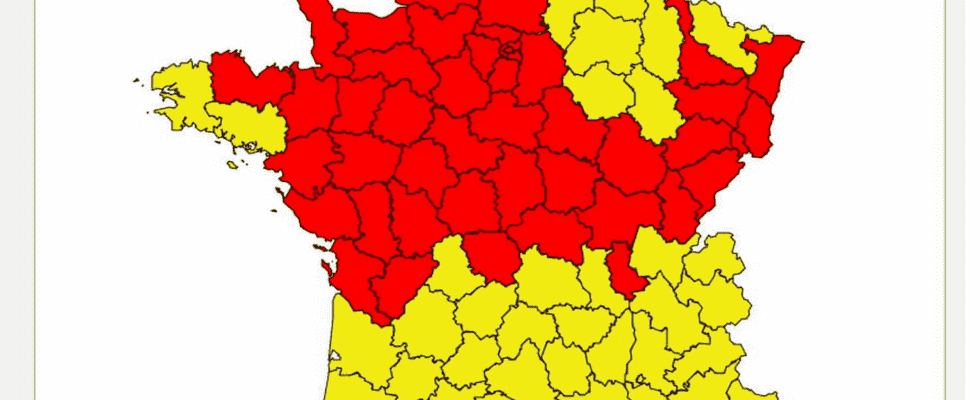2022 ALLERGY CARD. The wave of cold and rain brings some respite to those with allergies even if birch pollen is present. In which departments is the allergic risk the highest? Image and advice for allergy sufferers.
Itching in the eyes, in the throat, itchy, runny nose… A pollen allergy is manifested by several characteristic symptoms. In Francethe first allergies start in February with the cypress pollens, then arrive in April those of grassesfrom birch (especially in the north of France) and continue thesummer with those of ambrosia. The study of the content of the air in biological particles (pollens in particular) which can have an impact on the allergic risk for the population is carried out by the National Aerobiological Surveillance Network (RNSA), an association created in 1996 to continue the work carried out since 1985 by the Aerobiology Laboratory of the Pasteur Institute in Paris. According to the last April 2 newsletterthe Pollen disperses less since the cold snap and rain in France, which offers some respite to allergy sufferers. What are the pollens currently present in France? Which departments are in the red? What advice for allergy sufferers?
What are the pollens currently present in France?
The pollen produced by flowers is made up of tiny grains that are used for plant reproduction. The main manifestations of pollen allergy are allergic rhinitis (or allergic rhino-conjunctivitis), also called “hay fever”. It exists three main categories of pollen : tree pollens (birch, plane tree, etc.), grasses (wheat, oats, etc.) and herbaceous plants (nettle, ambrosia, etc.).
In France, the main plant species responsible for allergies are:
- grasses (April to July)
- birch (April, especially in northern France)
- the cypress (February to April)
- mugwort ragweed (August, September)
Right now, according to National Aerobiological Monitoring Network (RNSA):
- the birch pollen will be present, causing a medium to high risk of allergy in the northern half of the country, especially on Sunday April 3 and Monday April 4, before a new period of rain limits the presence of pollen in the air.
- the ash pollen are not to be outdone with a medium to high risk of allergy throughout the country.
- the grass pollen disperse a little on the western side of the country and in the Mediterranean, which will bother the most sensitive people.
- the plane tree pollen are also very numerous, but the risk of allergy linked to these pollens will not exceed the average level.
- The cupressaceae pollen are decreasing in the Mediterranean and the risk of allergy linked to these pollens will be at an average level in this region.
In which departments is the risk of allergy high?
List of departments where the risk of allergy is high according to the National Aerobiological Monitoring Network : Pas-de-Calais (62), North (59), Seine-Maritime (76), Oise (60), Manche (50), Calvados (14), Eure (27), Val-d’Oise (95) , Seine-et-Marne (77), Yvelines (78), Orne (61), Côtes-d’Armor (22), Ille-et-Vilaine (35), Mayenne (53), Sarthe (72), Eure- et-Loire (28), Essonne (91), Seine-et-Marne (77), Loire-Atlantique (44), Maine-et-Loire (49), Sarthe (72), Loir-et-Cher (41), Loiret (45), Yonne (89), Coast -d’Or (21), Haute-Saône (70), Territory of Belfort (90), Haut-Rhin (68), Vosges (88), Bas-Rhin (67), Meurthe-et-Moselle (54), Var (83), Rhône (69), Allier (03), Creuse (23), Charente (16), Charente-Maritime (17), Deux-Sèvres (79), Vienne (86), Vendée (85), Indre (36), Cher (18), Nièvre (58), Mayenne (53), Seine-Saint-Denis (93), Hauts-de-Seine (92), Val-de-Marne (94), Paris (75).
What to do if you are allergic to limit the symptoms?
The RNSA recommends that allergy sufferers:
- to follow their treatments and consult the doctor in case of symptoms,
- regularly consult the pollen vigilance map on the RNSA website
- rinse your hair at night,
- ventilate at least 10 minutes a day before sunrise and after sunset,
- avoid drying clothes outside,
- keep car windows closed to prevent pollen from entering the passenger compartment,
- avoid outdoor sports activities that lead to overexposure to pollen.
- Also beware of air pollution, which can exacerbate pollen allergies.
What are the differences between the symptoms of an allergy and Covid?
The priority for allergy sufferers, despite the coronavirus epidemic, is to maintain their background treatment to better control asthma and avoid complications. Caution of do not confuse the symptoms of Covid-19 and pollen allergy.
As the RNSA reminds us, the dry cough or respiratory problems linked to asthma are indeed quite similar to those of the first symptoms of Covid-19 infection, but what makes the big difference for Covid-19 is flu syndrome (pain, body aches, fever). If in doubt, do not hesitate to consult your doctor or an allergist.
